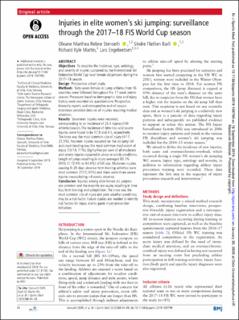| dc.contributor.author | Stenseth, Oleane Marthea Rebne | |
| dc.contributor.author | Barli, Sindre Fløtlien | |
| dc.contributor.author | Martin, Richard Kyle | |
| dc.contributor.author | Engebretsen, Lars | |
| dc.date.accessioned | 2020-05-14T09:13:33Z | |
| dc.date.available | 2020-05-14T09:13:33Z | |
| dc.date.created | 2019-11-12T17:41:39Z | |
| dc.date.issued | 2019 | |
| dc.identifier.citation | British Journal of Sports Medicine. 2020, 54(1), 44-48. | en_US |
| dc.identifier.issn | 0306-3674 | |
| dc.identifier.uri | https://hdl.handle.net/11250/2654397 | |
| dc.description | This is an open access article distributed in accordance with the Creative Commons Attribution Non Commercial (CC BY-NC 4.0) license, which permits others to distribute, remix, adapt, build upon this work non-commercially, and license their derivative works on different terms, provided the original work is properly cited, appropriate credit is given, any changes made indicated, and the use is non-commercial. See: http://creativecommons.org/licenses/by-nc/4.0/. | en_US |
| dc.description.abstract | Objectives: To describe the incidence, type, aetiology and severity of injuries sustained by the International Ski Federation World Cup level female ski jumpers during the 2017–18 season. Design: Prospective cohort study. Methods: Sixty-seven female ski jump athletes from 16 countries were followed throughout the 17-week winter season. Preseason baseline demographic data and injury history were recorded via questionnaire. Prospective biweekly reports and retrospective end-of-season interviews provided data on all injuries requiring medical attention. Results: Seventeen injuries were recorded, corresponding to an incidence of 25.4 injuries/100 athletes/season. The incidence of time-loss and severe injuries were found to be 17.9 and 4.5, respectively. The knee was the most common site of injury (4/17; 23.5%). Fourteen injuries occurred on the ski jump hill and crash-landing was the most common mechanism of injury (10/14; 71%). Eighty-five per cent of all moderate and severe injuries occurred in snow or windy conditions. Length of jumps resulting in injury averaged 83.7% (95% CI 72.9% to 94.4%) of hill size. Moderate injuries causing 8–28 days absence from training activities were most common (7/17; 41%) and there were three severe injuries necessitating >4 weeks absence. Conclusion: Injuries among elite female ski jumpers are common and the majority are acute, resulting in time loss from training and competition. The knee was the most common site of injury and poor weather conditions may be a risk factor. Future studies are needed to identify risk factors for injury and to guide injury prevention initiatives. | en_US |
| dc.language.iso | eng | en_US |
| dc.subject | sports injuries | en_US |
| dc.subject | prevention programs | en_US |
| dc.subject | illnesses | en_US |
| dc.subject | knee | en_US |
| dc.title | Injuries in elite women's ski jumping: Surveillance through the 2017-18 FIS World Cup season | en_US |
| dc.type | Peer reviewed | en_US |
| dc.type | Journal article | en_US |
| dc.description.version | publishedVersion | en_US |
| dc.rights.holder | © Author(s) (or their employer(s)) 2020. | en_US |
| dc.source.pagenumber | 44-48 | en_US |
| dc.source.volume | 54 | en_US |
| dc.source.journal | British Journal of Sports Medicine | en_US |
| dc.identifier.doi | 10.1136/bjsports-2019-100799 | |
| dc.identifier.cristin | 1746742 | |
| dc.description.localcode | Seksjon for idrettsmedisinske fag / Department of Sports Medicine | en_US |
| cristin.unitcode | 150,34,0,0 | |
| cristin.unitname | Seksjon for idrettsmedisinske fag | |
| cristin.ispublished | true | |
| cristin.fulltext | original | |
| cristin.qualitycode | 2 | |
